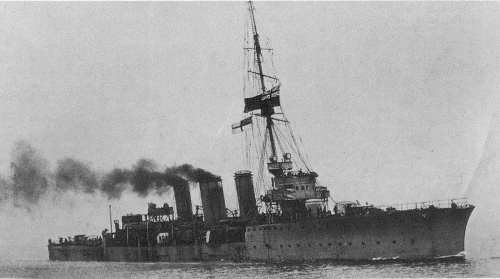
NAVYPEDIA
 Support the project with paypal
Support the project with paypal
Photo

Phaeton 1915
Ships
| Name | No | Yard No | Builder | Laid down | Launched | Comp | Fate |
|---|---|---|---|---|---|---|---|
| Aurora | Devonport DYd, UK | 24.10.1912 | 30.9.1913 | 9.1914 // 11.1920 | sold for BU 8.1927 |
Technical data
| Displacement normal, t | 3750 |
|---|---|
| Displacement full, t | 4400 |
| Length, m | 132.9 |
| Breadth, m | 11.9 |
| Draught, m | 4.10 |
| No of shafts | 4 |
| Machinery | 4 Parsons steam turbines, 8 boilers |
| Power, h. p. | 40000 |
| Max speed, kts | 28.5 |
| Fuel, t | oil 875 |
| Endurance, nm(kts) | 3200(16) |
| Armour, mm | belt: 76 - 25, deck: 25, CT: 76, gun shields: 102 |
| Armament | 2 x 1 - 152/45 BL Mk XII, 6 x 1 - 102/45 QF Mk V, 2 x 1 - 76/45 20cwt QF Mk I, 4 x 2 - 533 TT, 70 - 74 mines |
| Complement | 276 - 282 |
Standard scale images

Royalist 1919
Graphics
Project history
The grave shortage of cruisers capable of working with the Fleet was matched by a lack of ships for strengthening the flotillas. By 1911 the speed of destroyers had made it impossible for the 'Scouts' to lead a high-speed dash and that gap would widen with the introduction of what became the 'K' and 'L' classes. To examine the problem a Cruiser Committee was set up by the new First Lord, Churchill, late in 1911. Two basic lines of development were examined: a super-Swift or enlarged destroyer relying only on speed, or a super-Active, an enlarged scout with lower speed but some armour protection and a much heavier armament. As might be expected, Fisher wanted the super-Swift because of its alleged high speed (37kts), but Churchill backed the 'cruiser admirals' on the committee in their preference for an uprated 'Scout'. She would cost £285,000 as against £350,000 for a Dartmouth. By working in the armour as part of the longitudinal strength the DNC was able to increase the armour protection amidships. The E-in-C, Sir Henry Oram, proposed to use fast-running destroyer turbines and boilers to get speed up from 28 to 30 or even 31kts. The higher speed proved illusory as so much extra weight was worked into the design but even so a sea speed of 27.5kts was a great improvement over previous cruisers. Many sources quote the installed power as 30,000shp. This was the designed hp, with an extra 10,000shp load but in practice the load shp came to be used as standard. Proposed armaments were 10 102mm, as in the 'Scouts' or 5 152mm, but ultimately a compromise of 2 152mm and 6 102mm was chosen. When presented to Parliament, Churchill described them as 'light armoured cruisers', to emphasise the protection for they were the smallest British warships to be protected by vertical armour. In practice the Arethusa class proved successful in the North Sea, although very cramped as a result of wartime additions. They would not have been able to replace the 'Towns' on overseas stations, as witness the fact that the Arethusas disappeared very quickly after the war, whereas many of the older 'Towns' were kept on for some years.
Protection
Armoured belt protected ship at full length, its thickness was 76mm abreast machinery spaces (51mm armour on 25mm plating), 51mm (38mm armour on 13mm plating) aft and 38mm (25mm armour on 13mm plating) fore. Belt was closed by aft 25mm bulkhead near stern. It extended to main deck (and to upper deck abreast machinery). Machinery and steering gear were covered by 25mm deck.
Modernizations
None.
Naval service
No significant events.
© Ivan Gogin, 2015
 HOME
HOME FIGHTING SHIPS OF THE WORLD
FIGHTING SHIPS OF THE WORLD CANADA
CANADA CRUISERS
CRUISERS AURORA light cruiser (1914/1920)
AURORA light cruiser (1914/1920)
